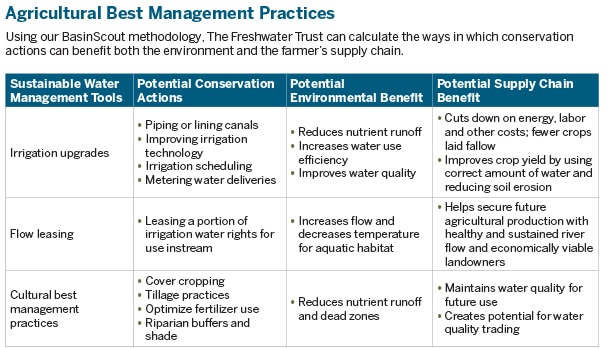The whole is greater than the sum of its parts: Stewarding the ‘Farm of the Future’
February 21, 2016
For decades, conservation and agriculture have been at odds, failing to recognize that insufficient water doesn’t only harm the environment; it threatens the future of agriculture itself.
And if anything’s lost out on this age-old rift, it’s America’s rivers.
After World War II, advancements in technology simplified landscapes and put more ground under active cultivation. With fertilizer formulas becoming more sophisticated in the 1960s, farm productivity radically increased. Further — and perhaps most significantly — farm runoff was exempted from the Clean Water Act. Since then, aquatic dead zones have been doubling each decade, and today, there are more than 400 around the globe. The one at the end of the Mississippi River is larger than the state of New Jersey.
And look no further than the mess that is California – ground sinking by literal feet a year, reservoirs depleted, and entire towns with dry faucets – to understand we have an immense, national water quantity issue on our hands.
More than 70 percent of freshwater goes to growing crops and raising animals.
With the population set to boom by more than a billion per decade — and 4 billion already impacted by water scarcity — we must ask ourselves: How do we feed this planet without destroying the single most critical natural resource supporting us all?
As a headline from Newsweek recently read, “We need the farms of the future today.”
Using satellite imagery, sensors and weather tracking, farmers can now make more accurate, real-time judgments about where and when to water and apply fertilizer. These inputs can be applied more efficiently, leading to higher profits for farmers, less fertilizer in nearby waterways and less water wasted. OnFarm, a startup that builds data dashboards for some of the nation’s largest food producers, calls all of this “decision farming.” Their tag line? Grow informed.
In a similar vein, The Freshwater Trust has developed a tool called BasinScout, where we can combine aerial images with existing data and identify conservation projects on specific farms and plots of land that are going to go the furthest toward restoring our rivers and streams. Conservation informed.
Through this data, we’re able to understand where taking simple actions, such as fencing livestock away from rivers and planting buffers of native vegetation between a field and a waterway, can make big differences.
But while data, sensors and satellites will get us part of the way to a future with enough fishable, swimmable, drinkable water, fixing this problem will also require simple human interaction between communities that have too long been at odds.We need both breakthroughs in technology and breakthroughs in societal barriers.
Between 2012 and 2015, The Freshwater Trust worked with farmers and ranchers to implement a series of voluntary, targeted conservation actions on their land. As a result, 1,800 pounds of nitrogen and phosphorus and 467,000 pounds of sediment were prevented from entering several Oregon rivers.
Imagine replication on farms nationwide.
We also work with willing landowners to lease us a portion of their water rights for instream use. We’ve negotiated more than 150 water deals like this with farmers and ranchers in the West. In 2014, more than 87 million gallons of water were kept in rivers this way – rivers that desperately needed it.
From years of conflict we have come, but to years of innovation and collaboration we must go.
Small individual actions on a landscape can add up to big problems.
Each farmer may take a small amount of water from the stream, but when these actions are combined, that diverted water can eventually mean a dry creek. Each farmer applies a small amount of nitrogen to a field of crops, but when combined, too much nitrogen can run into the rivers and choke out aquatic life and impair a drinking water supply.
Yet in the exact same way, positive actions of individuals can also add up to a big solution.
For the sake of freshwater, food and future generations, the sum of our actions together is certainly greater than our individual parts.
This is 21st century conservation.
Our 33rd annual gala & auction held on February 26, 2016 celebrated our efforts to continue stewarding the “Farm of the Future.”
————

#agriculture #BasinScout #California #community #Conservation #data collecting #freshwater #livestock #OnFarm #positive action #rivers #working together
